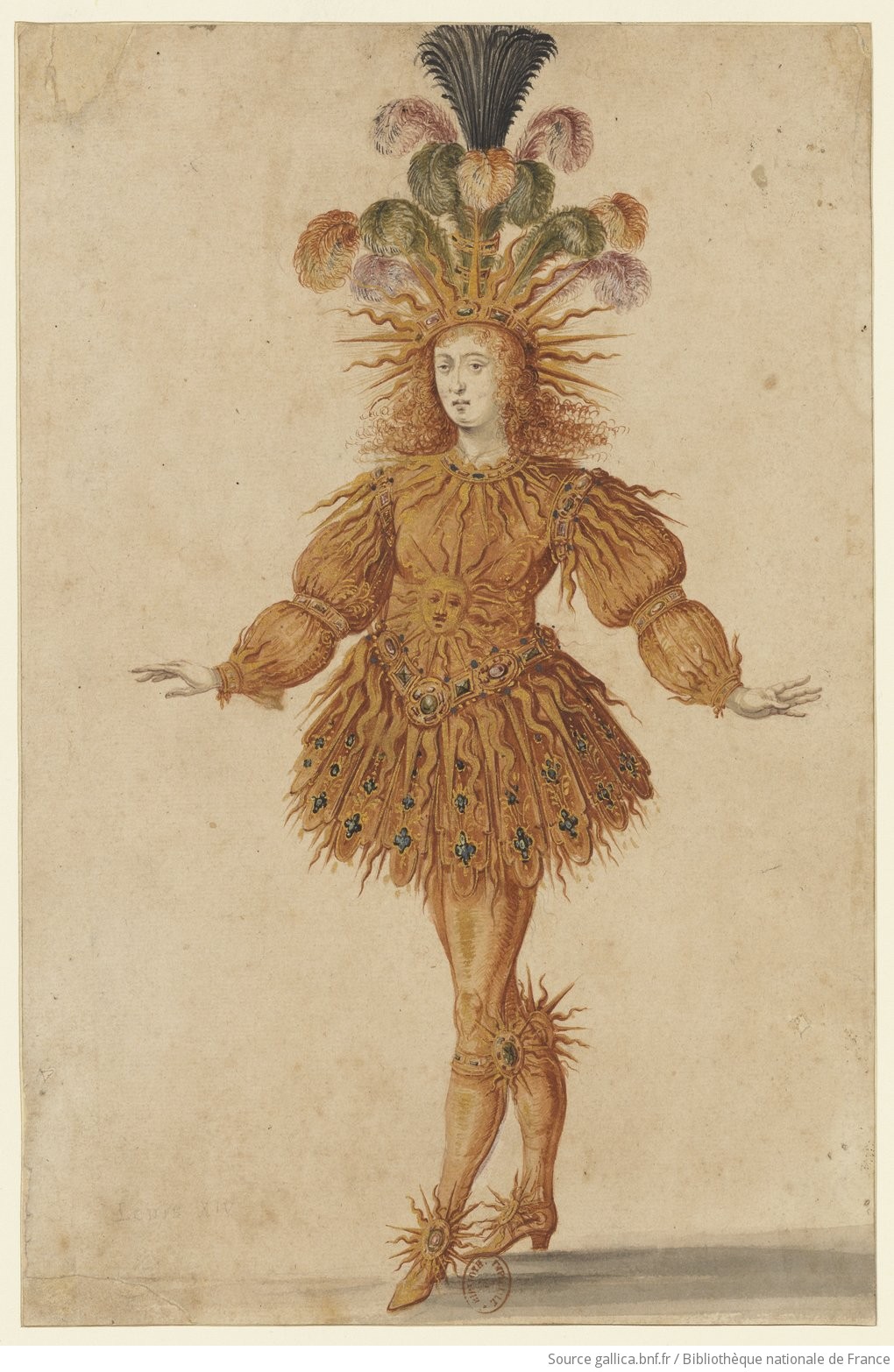Le Ballet Royal de la Nuit, performed at Caen last month, broadcast on France Musique HERE, with Sébastien Daucé and Ensemble Correspondances who recreated the spectacle for modern audiences, preserved in their recording for Harmonia Mundi in 2015. The original was performed only once, on 23rd February 1653, in the palace of Petit-Bourbon in Paris : an extravaganza where the star was its subject : Louis XIV, the King of France. No way could the original be matched today. It ran for 13 hours solid, from darkness to dawn, dawn being, of course the return of the sun. Thus Louis revealed himself as the Sun King, his countenance bringing light to the nation. He appeared, in the costume pictured right, dressed as the sun, the centre of the solar system, the bringer of light and growth. An audacious statement, so dazzling that the court was stunned into submission. And he was only 14 years old. Though Louis wasn't formally crowned until the following year, Le Ballet Royal de la Nuit marked the beginning of his reign of glory.
Le Ballet Royal de la Nuit also marks the beginning of modern music, opera and ballet. It comprised music from several composers, (Jean de Cambefort, Antoine Boësset, Louis Constantin, Michel Lambert — Lully's father-in-law, Francesco Cavalli, Luigi Rossi), secular as well as religious. It evolves in four parts, comprising numerous scena and interludes, depicting the known and unknown world. Gods and Symbolic Dieties mix with mortals and (glorified) peasants, represented the multitudes whom Louis would rule over, in fact as well as in allegory. Musicians, singers, dancers, acrobats, jugglers : the plethora of styles and skills reflected the diversity of the Empire and the scale of Louis's ambition, the abundance of human experience elegantly ordered into artistic form. Later, Louis's minions would create the gardens of Versailles, "civilizing" nature in formal parterres, preserving the forests beyond, for hunting. In the Grand Ballet with which the spectacle ends, Louis danced - not folk dance by any means, but a form of pageant derived from courtly disciplines like gymnastics. Fencing was aristocrat physical fitness, but also good training for minds that had to keep alert and wary, keeping counsel but acting swiftly and decisively when need. arose. Medieval jousting, adapted for more sophisticated intrigue. Dance was a principal foundation of French Opéra, but also influenced the development of French music in a wider sense,where the virtues of clarity, lucidity and intelligence prevail. Passion is no less intense in a cultivated mind, it's just more focused.
Le Ballet Royal de la Nuit is a metaphor for French style. Its audacity lies in its extravagant imagination, elegance restraining excess, technical achievement balanced by refinement, agility and energy. When Sébastien Daucé and Ensemble Correspondances made their recording for Harmonia Mundi, the release was audio only, though the performance was partly staged. Yet this first great Gesammstkunstwerk was meant to be seen as well as to be heard. Perhaps one day, who knows? Til then, there are clips and stills to stimulate the mind. Read more about the original HERE and enjoy the videos in THIS LINK.
Le Ballet Royal de la Nuit also marks the beginning of modern music, opera and ballet. It comprised music from several composers, (Jean de Cambefort, Antoine Boësset, Louis Constantin, Michel Lambert — Lully's father-in-law, Francesco Cavalli, Luigi Rossi), secular as well as religious. It evolves in four parts, comprising numerous scena and interludes, depicting the known and unknown world. Gods and Symbolic Dieties mix with mortals and (glorified) peasants, represented the multitudes whom Louis would rule over, in fact as well as in allegory. Musicians, singers, dancers, acrobats, jugglers : the plethora of styles and skills reflected the diversity of the Empire and the scale of Louis's ambition, the abundance of human experience elegantly ordered into artistic form. Later, Louis's minions would create the gardens of Versailles, "civilizing" nature in formal parterres, preserving the forests beyond, for hunting. In the Grand Ballet with which the spectacle ends, Louis danced - not folk dance by any means, but a form of pageant derived from courtly disciplines like gymnastics. Fencing was aristocrat physical fitness, but also good training for minds that had to keep alert and wary, keeping counsel but acting swiftly and decisively when need. arose. Medieval jousting, adapted for more sophisticated intrigue. Dance was a principal foundation of French Opéra, but also influenced the development of French music in a wider sense,where the virtues of clarity, lucidity and intelligence prevail. Passion is no less intense in a cultivated mind, it's just more focused.
Le Ballet Royal de la Nuit is a metaphor for French style. Its audacity lies in its extravagant imagination, elegance restraining excess, technical achievement balanced by refinement, agility and energy. When Sébastien Daucé and Ensemble Correspondances made their recording for Harmonia Mundi, the release was audio only, though the performance was partly staged. Yet this first great Gesammstkunstwerk was meant to be seen as well as to be heard. Perhaps one day, who knows? Til then, there are clips and stills to stimulate the mind. Read more about the original HERE and enjoy the videos in THIS LINK.

No comments:
Post a Comment